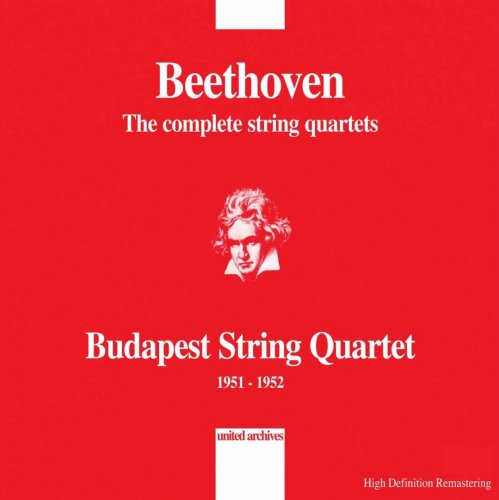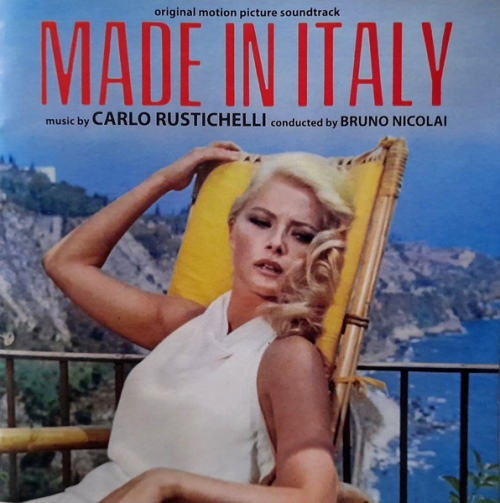Budapest String Quartet - Beethoven: The Complete String Quartets 1951-1952 (2006)

Artist: Budapest String Quartet
Title: Beethoven: The Complete String Quartets 1951-1952
Year Of Release: 2006
Label: United Archives
Genre: Classical
Quality: FLAC (image + .cue)
Total Time: 08:04:44
Total Size: 1.84 GB
WebSite: Album Preview
Tracklist:Title: Beethoven: The Complete String Quartets 1951-1952
Year Of Release: 2006
Label: United Archives
Genre: Classical
Quality: FLAC (image + .cue)
Total Time: 08:04:44
Total Size: 1.84 GB
WebSite: Album Preview
CD 1
String Quartet No.1 in F major, Op.18/1
01] Allegro con brio (7:14)
02] Adagio affettuoso ed appassionato (9:59)
03] Scherzo (3:11)
04] Allegro (6:22)
String Quartet No.2 in G major, Op.18/2
05] Allegro (5:35)
06] Adagio cantabile (6:23)
07] Scherzo & Trio (4:03)
08] Allegro molto quasi presto (5:30)
String Quartet No.3 in D major, Op.18/3
09] Allegro (5:38)
10] Andante con moto (7:37)
11] Allegro (2:54)
12] Presto (4:23)
CD 2
String Quartet No.4 in C minor, Op.18/4
01] Allegro ma non tanto (6:51)
02] Scherzo: Andante scherzoso quasi allegretto (5:32)
03] Menuetto: Allegretto (4:16)
04] Allegro (4:34)
String Quartet No.5 in A major, Op.18/5
05] Allegro (6:49)
06] Menuetto (5:21)
07] Andante cantabile (10:03)
08] Allegro (5:01)
String Quartet No.6 in Bb major, Op.18/6
09] Allegro con brio (4:41)
10] Adagio ma non troppo (6:55)
11] Scherzo e trio: Allegro (3:14)
12] La Malinconia: Adagio, Allegretto quasi allegro (8:48)
CD 3
String Quartet No.7 in F major, Op.59/1
01] Allegro (10:26)
02] Allegretto vivace e sempre scherzando (9:33)
03] Adagio molto e mesto (11:47)
04] Allegro (6:05)
CD 4
String Quartet No.8 in E minor, Op.59/2
01] Allegro (7:41)
02] Molto adagio (12:27)
03] Allegretto (5:21)
04] Finale. Presto (5:51)
String Quartet No.9 in C major, Op.59/3
05] Introduzione. Andante con moto - Allegro vivace (8:19)
06] Andante con moto quasi allegretto (9:08)
07] Menuetto. Grazioso (5:23)
08] Allegro molto (6:18)
CD 5
String Quartet No.10 in Eb major, Op.74 "Harp"
01] Poco adagio - Allegro (8:23)
02] Adagio ma non troppo (9:28)
03] Presto (4:31)
04] Allegretto con variazioni (6:55)
String Quartet No.11 in F minor, Op.95 "Serioso"
05] Allegro con brio (4:41)
06] Allegretto ma non troppo (7:02)
07] Allegro assai vivace ma serioso (4:50)
08] Larghetto espressivo - Allegretto agitato (5:16)
CD 6
String Quartet No.12 in Eb major, Op.127
01] Maestoso - Allegro (6:38)
02] Adagio ma non troppo e molto cantabile (14:55)
03] Scherzando vivace (7:10)
04] Finale (6:43)
String Quartet No.14 in C# minor, Op.131
05] Adagio ma non troppo e molto espressivo (6:53)
06] Allegro molto vivace (3:10)
07] Allegro moderato - Adagio (0:44)
08] Andante ma non troppo e molto cantabile (13:33)
09] Presto (5:27)
10] Adagio quasi un poco andante (1:46)
11] Allegro (6:41)
CD 7
String Quartet No.13 in Bb major, Op.130
01] Adagio ma non troppo - Allegro (9:51)
02] Presto (1:50)
03] Andante con moto ma non troppo (6:37)
04] Alla danza tedesca. Allegro assai (3:26)
05] Cavatina. Adagio molto espressivo (6:39)
06] Große Fuge in Bb major, Op.133 (16:26)
07] Finale (alternativo). Allegro (7:39)
CD 8
String Quartet No.15 in A minor, Op.132
01] Assai sostenuto - Allegro (9:45)
[2] Allegro ma non tanto (9:02)
03] Molto adagio (15:49)
04] Alla marcia, assai vivace (2:21)
05] Allegro appassionato (6:39)
String Quartet No.16 in F major, Op.135
06] Allegretto (6:34)
07] Vivace (3:08)
08] Lento assai, cantante e tranquillo (7:43)
09] Grave ma non troppo tratto - Allegro (6:57)
Founded in 1917 in Budapest, Hungary, the Budapest Quartet became the most internationally successful chamber ensemble of modern times. Across 50 years, and a repertory ranging from Mozart to Bartók, the group brought chamber music of these composers to audiences on two continents, and further popularized the music through their recordings.
The Budapest Quartet's original members were Emil Hauser, Imre Poganyi, Istvan Ipolyi, and Harry Son, all of whom had played in the Budapest Opera Orchestra. Their debut concert in 1917, at Kolozsvar in Hungary, was a great success, and by the early 1920s they'd begun touring Europe. The group was acclaimed by audiences and critics everywhere for their superb ensemble playing and the depth and insight that they brought to their repertory, which extended from the Classical to the contemporary, including the quartets of Bartók and Kodály.
The group flourished during the late 1920s and early 1930s despite numerous membership changes. Joseph Roisman, who joined on second violin in 1927, became the leader of the group a few years later, replacing Emil Hauser in the 1930s. Ipolyi was succeeded by Alexander Schneider, while Son was replaced by Schneider's brother Mischa, and in 1936 Boris Kroyt joined on the viola.
The second generation Budapest Quartet was, if anything, even more technically impressive than the first, more incisive in its playing, and overall faster, with more frequent (and modern) use of vibrato. Roisman's leadership brought the group to America, at first simply on tour, and also into the recording studio in a serious way for the first time. From 1938 onward, amid the growing uncertainty of life in Europe, the Budapest Quartet moved to the United States and was based for the next 24 years as the quartet-in-residence at the Library of Congress in Washington, D.C., before moving to the State University of New York at Buffalo in 1962. Among their more notable work for the Library of Congress, they recorded Schubert's "Trout" Quintet and other works with the conductor George Szell on the piano during 1945 and 1946. Their major commercial recording activity, however, was done for Columbia Masterworks (now Sony Classical) beginning in the early 1950s.
Key to the group's repertory during their American era were the Beethoven quartets, which they recorded several times and performed complete nearly every year. For performances of the quintets, they were augmented with the presence of Milton Katims and Walter Trampler. Their work continued until 1967, when they gave their last performance. The ravages of age and illness forced the retirement of Mischa Schneider, and then Roisman and Kroyt.
The Budapest Quartet was among the most honored and respected chamber ensembles of the early and middle twentieth century, an era in which the orchestra was the dominant force in classical music. The performances of the original quartet brought the chamber music of such varied composers as Mozart and Bartók to a wider audience than ever before, and the later group's embrace of the Beethoven quartets and quintets, in concert and on record, gave these works the best hearings they had in modern times. -- Bruce Eder
The Budapest Quartet's original members were Emil Hauser, Imre Poganyi, Istvan Ipolyi, and Harry Son, all of whom had played in the Budapest Opera Orchestra. Their debut concert in 1917, at Kolozsvar in Hungary, was a great success, and by the early 1920s they'd begun touring Europe. The group was acclaimed by audiences and critics everywhere for their superb ensemble playing and the depth and insight that they brought to their repertory, which extended from the Classical to the contemporary, including the quartets of Bartók and Kodály.
The group flourished during the late 1920s and early 1930s despite numerous membership changes. Joseph Roisman, who joined on second violin in 1927, became the leader of the group a few years later, replacing Emil Hauser in the 1930s. Ipolyi was succeeded by Alexander Schneider, while Son was replaced by Schneider's brother Mischa, and in 1936 Boris Kroyt joined on the viola.
The second generation Budapest Quartet was, if anything, even more technically impressive than the first, more incisive in its playing, and overall faster, with more frequent (and modern) use of vibrato. Roisman's leadership brought the group to America, at first simply on tour, and also into the recording studio in a serious way for the first time. From 1938 onward, amid the growing uncertainty of life in Europe, the Budapest Quartet moved to the United States and was based for the next 24 years as the quartet-in-residence at the Library of Congress in Washington, D.C., before moving to the State University of New York at Buffalo in 1962. Among their more notable work for the Library of Congress, they recorded Schubert's "Trout" Quintet and other works with the conductor George Szell on the piano during 1945 and 1946. Their major commercial recording activity, however, was done for Columbia Masterworks (now Sony Classical) beginning in the early 1950s.
Key to the group's repertory during their American era were the Beethoven quartets, which they recorded several times and performed complete nearly every year. For performances of the quintets, they were augmented with the presence of Milton Katims and Walter Trampler. Their work continued until 1967, when they gave their last performance. The ravages of age and illness forced the retirement of Mischa Schneider, and then Roisman and Kroyt.
The Budapest Quartet was among the most honored and respected chamber ensembles of the early and middle twentieth century, an era in which the orchestra was the dominant force in classical music. The performances of the original quartet brought the chamber music of such varied composers as Mozart and Bartók to a wider audience than ever before, and the later group's embrace of the Beethoven quartets and quintets, in concert and on record, gave these works the best hearings they had in modern times. -- Bruce Eder

![Edgar Van Asselt - Penpals (2024) [Hi-Res] Edgar Van Asselt - Penpals (2024) [Hi-Res]](https://www.dibpic.com/uploads/posts/2025-11/1764482303_vzxrkm5ef69tb_600.jpg)






